Bill Jennings: Ski season also means winter vehicle preparedness season

Nearly a month of warm weather left me disoriented. About a day and a half after running on the High Drive bluff trails in shorts and t-shirt, a thin layer of snow coated the lawn on Monday morning. The scene reminded me that under normal circumstances, I’m in full-bore skiing mode this time of year.
The winter wake-up call also made me realize I wasn’t quite ready yet. I still remember where I’ve stowed all my gear. The skis were tuned last April at the end of the previous season. Physically, a year-round fitness routine should minimize my risk of injury. I might even avoid the crippling soreness that makes it hard to get out of the car after driving home from the first day on the hill.
Speaking of driving, one of my most important pieces of equipment for a safe and successful ski season had been woefully neglected. In certain ways, I was no different than the panicked throngs who mobbed Spokane tire stores after freaking out during their Monday morning commute.
Fortunately, my all-season tires still have a good amount of life left in them. I also drive a Subaru with continuous all-wheel drive that has been to hell and back through the harshest winter conditions. If I needed snow tires installed before taking advantage of mountain conditions that have been steadily improving this week, I’d have to get in line and hope for the best.
Fortunately there are things you and I can do on our own to ensure our tires are safe. First, look closely at the tread. According to the National Highway Traffic Safety Administration (nhtsa.gov), tread should be at the very least one-sixteenth-inch deep. Be aware that tire pressure drops along with the temperature. The vehicle manufacturer’s recommended inflation pressure is usually listed on a placard you will find on the driver’s side doorjamb. Don’t forget to check the spare.
Make sure your windshield wipers work and replace worn blades. Splurging on heavy-duty winter wipers is probably worth the investment. If you don’t feel comfortable changing wipers out yourself, find time to get your vehicle serviced as soon as possible, even if your oil isn’t quite due for a change.
Battery power also drops along with the temperature. Trustworthy mechanics will check your battery for voltage, inspect the charging system and belts, as well as do simple things like tightening the cable connections. They will check your coolant system for leaks or worn hoses, and recommend replacements and repairs.
Don’t be that person endangering him or herself and everyone else peering through a tiny defrosted porthole as you drive from the parking lot. Few things are as unpleasant as scraping a frozen windshield with a credit card, or sweeping off snow with soaking gloves and freezing hands.
Stock your vehicle with a broom and ice scraper. Carry a spare jug of windshield fluid. Throw in a flashlight, matches, an extra phone charger, blanket and a small snow shovel. Jumper cables will spread a lot of good karma for you.
Preparation leads to confidence. But Sergeant Jason Davis from the District 4 office of Washington State Patrol cautioned me that overconfidence often cancels out preparation.
“We see all kinds of good cars with good tires and equipment in the ditch,” he said. “Most of time it’s because of people not perceiving how quickly things can change – change of direction, change of speed. I tell my daughter its like walking on glass. You wouldn’t do anything quickly if you’re walking on glass.”
The inevitable collisions of Monday’s first snow attest to our short seasonal memories. Reacquaint yourself with how your vehicle handles in winter weather. If you lose traction, stay calm. Steer into the skid. Resist the reflex to stomp the brakes. Change lanes gradually. Increase your following distance with the vehicle ahead of you.
The better the mountain conditions are, the worse the driving conditions are likely to be. If your vehicle and your driving are as tuned as your gear, you have the best chance of enjoying the mountains to the fullest.